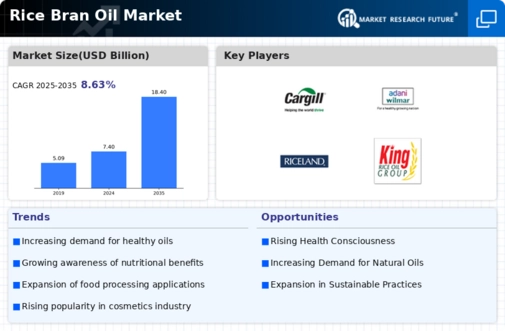Top Industry Leaders in the Rice Bran Oil Market

The competitive landscape of the rice bran oil market is marked by a diverse array of players, each vying for market share through distinctive strategies. As of 2023, key players dominating the industry include
- Associated British Foods PLC (UK)
- Ebro Foods, S.A. (Spain)
- Ingredion Incorporated (US)
- Archer-Daniels Midland Co. (US)
- Wilmar International Limited (Singapore)
- Bunge Ltd. (US)
- Whitworth Bros. Ltd. (UK)
- The Soufflet Group (France)
- Shipton Mill Ltd. (UK)
- KRÖNER-STÄRKE GmbH (Germany)
- Belourthe SA (Belgium)
- Bressmer & Francke (GmbH & Co.) KG (Germany)
- EDME Food Ingredients Limited (UK)
One prevalent strategy adopted by these key players is the emphasis on quality and nutritional benefits of their rice bran oil products. Ricela Health Foods Ltd., for instance, has focused on the production of premium quality rice bran oil, positioning itself as a provider of health-conscious cooking alternatives. Similarly, A.P. Refinery Pvt. Ltd. has invested in state-of-the-art refining processes to enhance the purity and nutritional value of its rice bran oil.
Strategic alliances and partnerships have also played a pivotal role in shaping the competitive landscape. Companies such as Sethia Oils Ltd. have entered into collaborations with international distributors to expand their global footprint. This approach not only aids in market penetration but also ensures a diversified revenue stream, reducing dependence on specific regions.
Factors influencing market share analysis in the rice bran oil sector encompass product differentiation, pricing strategies, and distribution channels. Premium quality offerings often command higher market share due to the growing demand for healthier cooking oils. Additionally, competitive pricing strategies, especially in emerging markets, contribute to increased adoption. Efficient distribution networks, covering both retail and institutional channels, also play a vital role in securing market share.
As the industry matures, new and emerging companies are making their mark by introducing innovative products and production techniques. Start-ups like NutraActive Beverages Pvt. Ltd. and Green Valley Oils Pvt. Ltd. are gaining traction by focusing on niche segments, such as organic and cold-pressed rice bran oils. These companies leverage their agility to adapt quickly to market trends and consumer preferences, posing a challenge to established players.
The rice bran oil market has witnessed notable industry news and investment trends in recent years. Notably, there has been a surge in investments towards research and development to enhance production efficiency and nutritional aspects of rice bran oil. Companies are also investing in sustainable and eco-friendly practices, aligning with the increasing consumer awareness and demand for environmentally responsible products.
Current company investment trends reveal a strategic shift towards vertical integration. Several key players are investing in backward integration by acquiring rice milling facilities to ensure a stable supply of raw materials. This not only mitigates the impact of price fluctuations in the rice market but also allows companies to exercise greater control over the quality of the rice bran extracted.
The overall competitive scenario in the rice bran oil market is marked by intense rivalry, as companies strive to gain a competitive edge through continuous innovation. Market players are investing in advanced technologies for oil extraction and refining processes, contributing to increased production efficiency and higher-quality end products. The emphasis on sustainable and eco-friendly practices is reshaping the competitive landscape, with environmentally conscious consumers influencing purchasing decisions.
In terms of recent developments in 2023, industry players are closely monitoring regulatory changes and global economic conditions. The imposition of trade tariffs and evolving food safety regulations has prompted companies to recalibrate their supply chain strategies. Additionally, there has been a notable uptick in mergers and acquisitions, with established players acquiring smaller companies to consolidate their market presence and expand their product portfolios.


